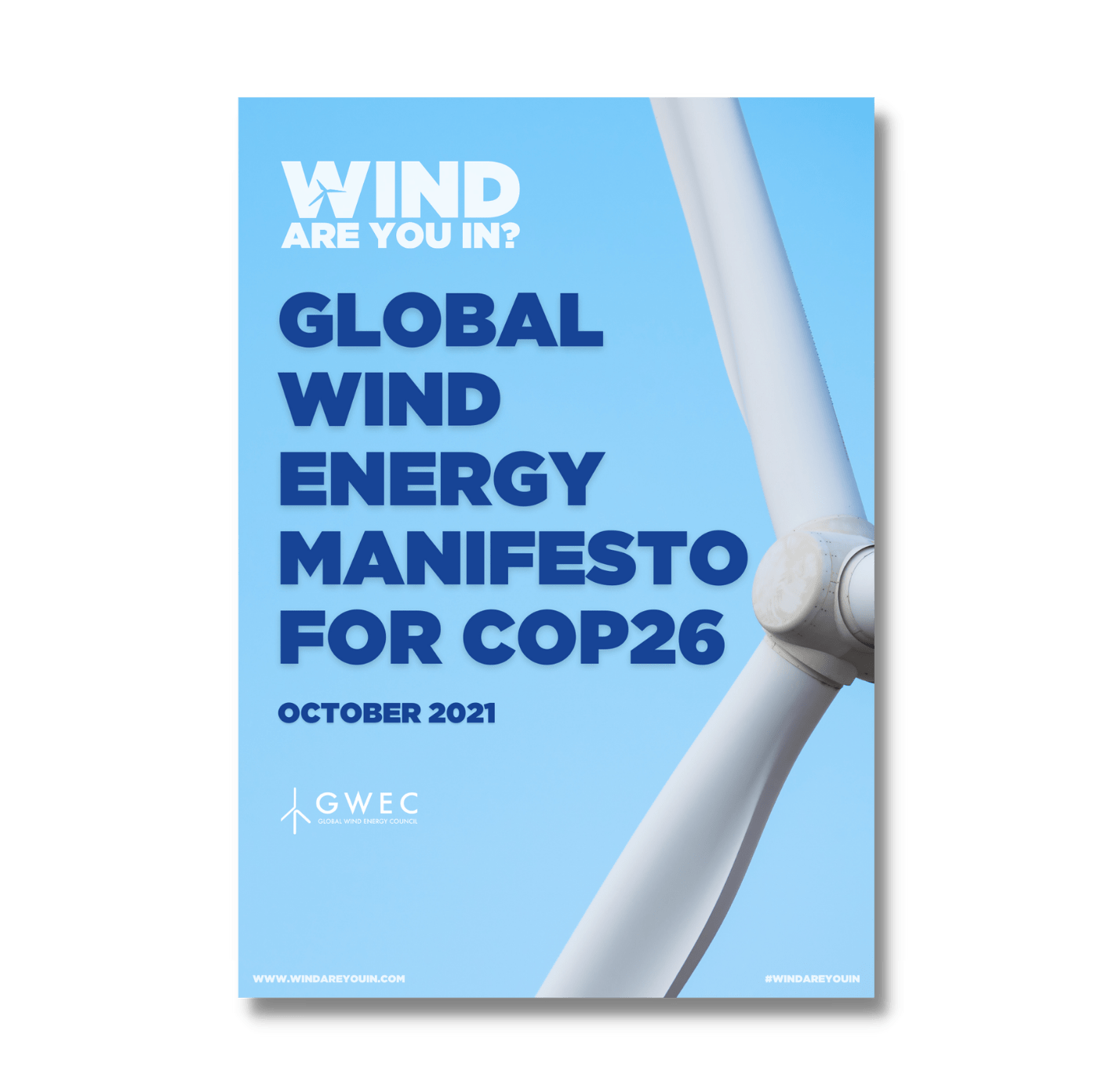
Wind energy is at the heart of climate change mitigation.
COP26 must be a watershed moment, beginning the decade of renewed action and collaboration to fight climate change. We already have the tools and technology to limit global warming, and even to achieve our shared target of net zero emissions by 2050. However, we need unprecedented political will and whole-of-society mobilisation to make it happen.
We need to work together to scale up wind energy to new heights, and safeguard our planet for future generations.
We are in. Are you?
Key Points
Increase wind power ambition and reflect this in updated Nationally Determined Contributions (NDCs), comprehensive national climate strategies and long-term energy plans.
Concrete wind capacity or generation targets should be set with a clear, detailed timeline and a horizon to achieve net zero. These targets should be aligned between the public bodies governing climate, energy, economy, environment, infrastructure and workforce, to ensure that the public sector is properly resourced to deliver them. Targets should also be set and implemented among carbon-intensive sectors and actors through public-private partnerships, renewable energy incentive programs, mandatory corporate disclosure schemes and other mechanisms. In addition to expanding electrification to increase the share of renewables in the energy mix, governments can consider green hydrogen solutions backed by wind power to decarbonise sectors such as heavy industry.
Commit to rapid phase out of coal-based generation now.
Burning coal is harmful to the public and the environment, and increasingly uneconomic compared to cost-competitive renewable energy. The rapid closure of coal plants worldwide beginning in 2022, and compliance with decommissioning/phaseout schedules, will make the difference between an above-2° and a 1.5° global warming pathway. It will also result in billions of dollars of savings in energy procurement and public health costs, which can be funnelled towards clean growth programmes. A global agreement on coal phaseout is urgently needed, and must include: a ban on investment in new coal plants by national export credit agencies, policy banks and multilateral development banks; a pledge from governments for no new coal plants and early closure of existing plants; and a mechanism which addresses transparency and accountability to meet these pledges and potential channels for fair compensation for early closures.
Design and implement energy markets for the future.
Energy market design must shift to reflect the systems of the future: flexible, responsive to demand, reliable and dependent on a majority (if not 100%) share of renewable energy. These systems are already in operation, and are technically and economically feasible around the world; but they require a level playing field to enable large-scale renewable energy deployment. This means: removing direct and hidden subsidies or advantages for fossil fuels generation; prioritising land/seabed allocation, procurement, construction, grid connection and dispatch for renewables-based generation; accounting for the socioeconomic and environmental costs of carbon; and realigning electricity market design to consider system value more widely, inclusive of externalities such as grid and balancing needs, energy system flexibility needs, emissions, environmental impact and socioeconomic benefits. This will also require widescale electrification to ensure that renewables can displace the role of fossil fuels in powering transport, heating and industry.
Implement streamlined and sensible permitting schemes for renewable energy projects to accelerate deployment and minimise project attrition.
Too many countries are unable to leverage the enormous interest from investors to deploy wind energy projects, due to overly complex and bureaucratic permitting schemes. Without streamlining the procedures to grant permits, including land allocation and grid connection, there will be a surplus of projects “stuck in the pipeline” and countries will miss their climate targets. Permitting lead times – which cover spatial planning, environmental and social impact assessment, planning authorisation, grid connection and legal challenges – are slowing down wind energy deployment in some world-leading wind markets, such as Germany and India.
Initiate plans to rapidly build out clean energy grids and charging stations for electric vehicles.
Greater public and private investment in secure, smart and flexible grids which enable ever-larger shares of renewable energy is necessary to meet the urgent pace of the energy transition. Through pooling expertise among system operators, regulators and utilities, public authorities can undertake long-term forward-planning on grid expansion and reinforcement, electrification of transport, as well as creating regional markets for power export and trading. Grid planning should also account for storage solutions, such as pumped hydro or utility-scale batteries, which can minimise grid congestion and support balancing.
Develop cohesive and inclusive policies which dedicate public resource to the people-centred shift to a net zero economy.
Global analysis by IRENA this year shows that enacting a 1.5°C-compliant energy transition results in net-positive socioeconomic effects, compared to current policies. By 2030, the world would have nearly 40 million more jobs generated by transition-related investments, such as large-scale wind and renewable energy deployment, grid enhancement and energy efficiency. The comparative value creation of the energy transition is also reflected in greater GDP and social welfare indicators. Steering the transfer of benefits to all communities is a critical component of the just transition. In particular, governments can initiate re-skilling and workforce transition schemes that identify alternative sustainable employment opportunities in clean energy for workers in sunset industries, such as fossil fuels and ancillary sectors. Here, the growing offshore wind sector offers a re-training pathway for workers in the offshore oil and gas and marine engineering fields.
Align national and regional finance flows with benchmarks for a net zero, 1.5°C-compliant pathway.
There is no shortage of capital for wind energy where an enabling investment environment exists. But to collectively achieve the energy transition, public funding – whether export finance or flows from state treasuries – must be decided under “do no harm” principles that address social and environmental impacts, and avoid the risk of stranded assets, especially fossil fuel assets. Climate targets should therefore be mainstreamed across financial ministries and public sector bodies. Public spending in support of renewable energy deployment should incorporate the perspectives of the private sector, particularly regarding project bankability and on-the-ground development barriers.
Advance voluntary cooperation on carbon pricing under Articles 6.2 and 6.4 of the Paris Agreement.
Effective and credible market approaches to carbon pricing can incentivise countries to “ratchet up” NDCs by creating mechanisms that recognise the societal costs of greenhouse gas emissions and pollution. Mechanisms which deter emissions at source, such as fair carbon border adjustment taxes on energy-intensive products, can send strong market signals to state and non-state actors in the power sector and beyond, supporting widescale divestment in fossil fuels and investment in low-carbon technologies.
List Of Signatories



Contact Our Team For Media Enquiries
Alex Bath
Communications Director
-
alex.bath@gwec.net